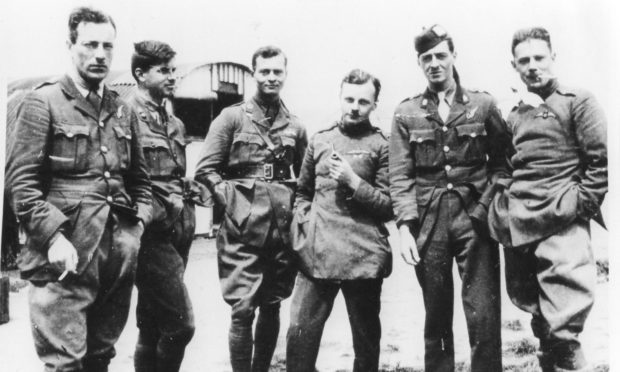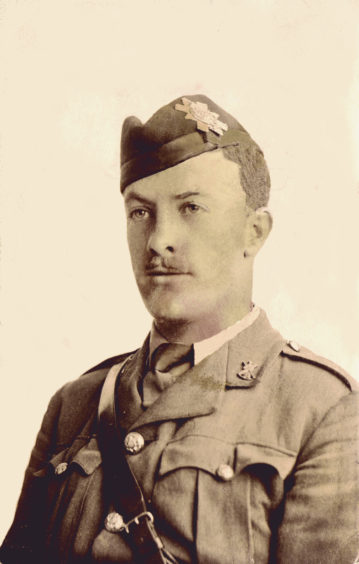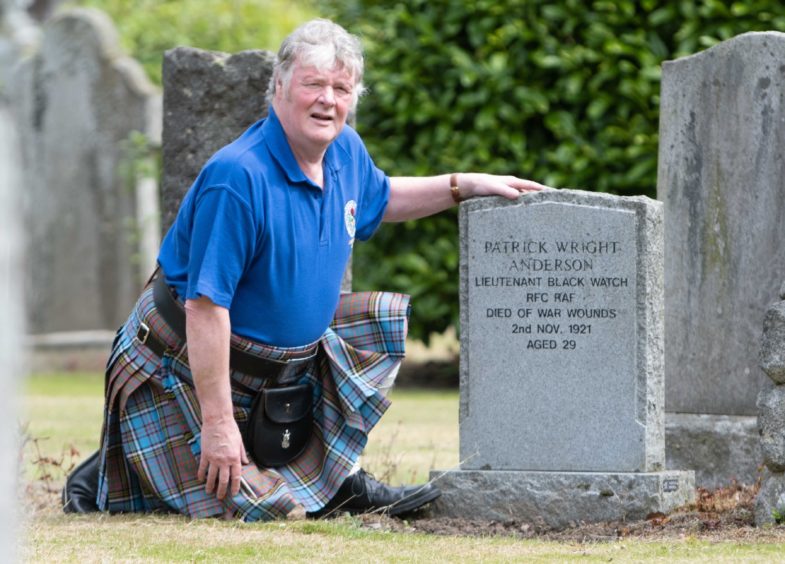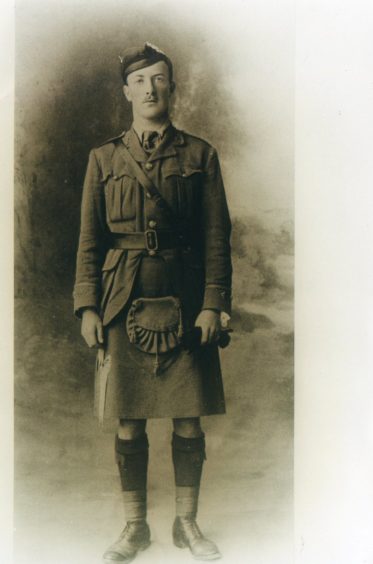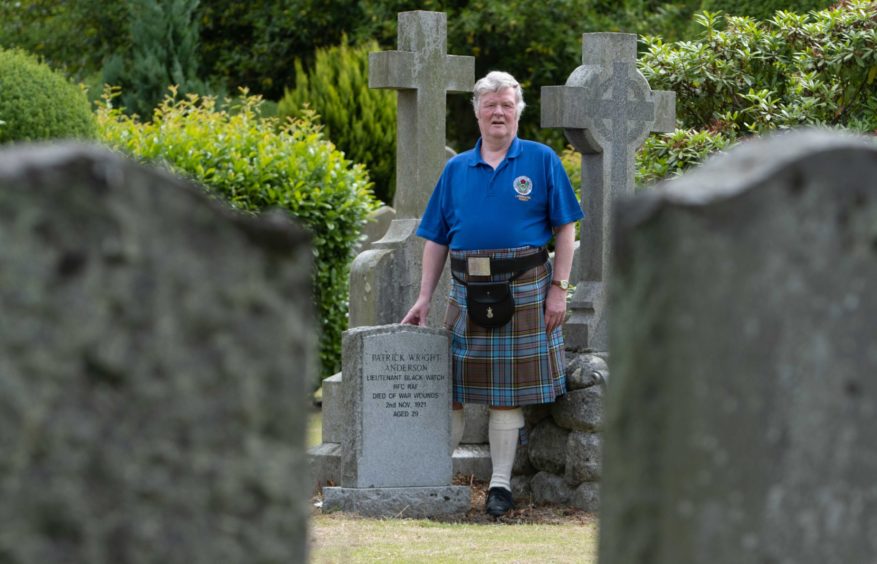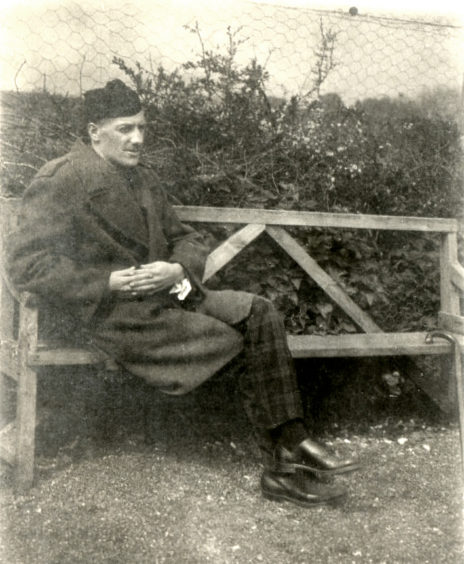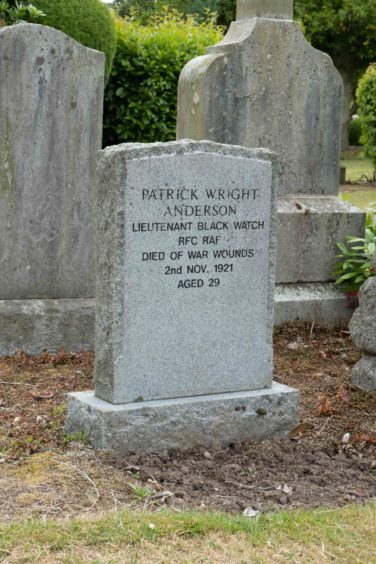Workers during the coronavirus crisis are not the first to find themselves ‘furloughed’.
Angus war hero Lieutenant Patrick Wright Anderson was sent to the south of France on prolonged furlough 100 years ago after being seriously injured over Flanders.
Lt Anderson then returned home from France and his health seemed to improve slightly but his hopes of a permanent recovery were not realised and he died in Arbroath Infirmary in 1921.
He had broken off his university studies to fight in the First World War.
In the Somme he would learn the true meaning of fear and test his own capacity for courage.
“Furlough is now a military word on Civvy Street,” said his nephew and namesake Patrick Anderson from Letham in Angus.
“My uncle was a student at St Andrews University and he went off to war to return ‘after Christmas’ to complete his studies.
“Sadly he never returned to university and he was just 29 when he died.”
Because Lt Anderson died after August 31 1921 he was not entitled to be listed in the War Graves Commission register or have an official ‘war graves’ headstone.
As a result of the efforts of his nephew, his name was added to the rolls of honour at the Scottish National War Memorial in Edinburgh Castle and the Tayforth Universities Officers Training Corps building in St Andrews.
Lt Anderson was born in 1892 in Arbroath and he was the only son of Patrick Wright Anderson, a book keeper with a lawyer’s firm, and Helen Anderson, who died in 1896.
Patrick Snr then married Jane Ann Addison following the tragedy, and they lived in Hill Street, with his sibling Florence, and half siblings Francis, Augustus, Harold, Jane and William, who became a lawyer in Arbroath.
He attended Arbroath High School and in 1910 was awarded the Science Medal.
The following year he became a maths and science student at the University College, Dundee, which was then part of St Andrews University.
He joined the University Officers Training Corps and volunteered for a commission as a Second Lieutenant in the 8th (Service) Battalion, Black Watch, following the outbreak of war.
One of the Battalion officers was Captain Fergus Bowes-Lyon, the older brother of the Queen Mother, who was killed in action at the Battle of Loos.
He transferred to the 10th (Service) Battalion during early 1915 where he was appointed Lieutenant and he continued training at Bristol and at Sutton Veny.
He did not go overseas to France with the Battalion during September 1915 but became the chief instructor at the 26th Division Grenade School at Villiers Bretonneux, which is 10 miles east of Amiens.
Mr Anderson said his uncle’s Battalion was posted to Salonika as part of the 77th Infantry Brigade, 26th Division.
At the end of December 1915 he was sharing a room in billets with a Lt Archie Don who was a son of the jute manufacturers Messrs Don Brothers, Buist and Co, which would later become Don and Low of Forfar.
Lt Don died a few months later of malaria and dysentery.
During the months of January to March 1916 Lt Anderson was chief instructor of a new grenade school at Salonika and from April to July of that year he was given the temporary rank of Captain whilst employed at that school.
During the following months he returned to active service with the Battalion and was involved in night raids near Dolozeli.
He was mentioned in several entries in the Battalion’s war diary including carrying a badly wounded soldier back to their lines.
On one night operation he was on active service with Lt Robin Don, brother of Lt Archie Don.
Lt Robin Don was killed in action during a night raid in 1917.
“Then my uncle must have applied to be an Observer in the Royal Flying Corps and left Salonika in November 1916 for training at Reading and Hythe,” said Mr Anderson.
“He was posted to St Omer in France and allocated to 18 Squadron, Royal Flying Corps, then based at Auchel in the Somme, where he was flying daytime bombers during November 1917.
“He was taken to the battle line and the Battle of Cambrai which marked the first large-scale use of tanks for a military offensive and his Commanding Officer was Major Ranald Reid MC who would later become Air Vice Marshal Sir Ranald Reid.
“He continued to wear his Highland officer’s uniform.”
Captain Lewis Collins from Dundee and Lt Walter Lyell from Gardyne Castle near Guthrie were also serving with 18 Squadron.
No name struck more fear into the hearts of Allied airmen than that of Manfred von Richthofen, who was better known as the Red Baron.
He was later shot down and killed in April 1918, but not before he became the war’s highest-scoring fighter ace.
Lt Anderson and his Canadian pilot shot down an out of control enemy machine on the same day.
They were mentioned in the RAF Communique for 1918.
On June 27 1918, he was on a morning patrol over Flanders with another Canadian pilot, Lt R C Bennett, when they were attacked by 10 enemy aircraft.
Mr Anderson said: “A number of 18 Squadron RAF day time bombers flew out of Serny airfield on the Somme to attack positions but just as the dog fight was nearly at an end a stray bullet badly wounded my uncle in the stomach and left thigh.
“He lost a great deal of blood but they managed to return to their lines.
“The stomach wounds were serious and his left thigh was shattered and he could not be moved from the casualty clearing station at Aire to go to a base hospital.
“He was visited by his Arbroath family doctor, Major J E G Thomson, MC, who was at that time acting Assistant Director of Medical Services of the 29th Division in the Somme.
“Major Thomson visited my uncle in the casualty clearing station on several occasions and wrote to my gran in Arbroath.
“He was later admitted to the RAF Hospital in Eaton Square in London which was then owned by the Duke of Devonshire which was affiliated to Queen Alexandra’s Military Hospital in Millbank.
“During 1919 he was moved to Swanage to the Grand Hotel which was then used as a convalescent hospital before he was put on an ambulance train from London to Arbroath arriving in the town on Armistice Day 1919.
“He relinquished his commission due to wounds received in war but was authorised to retain his rank.
“He was seen daily by Dr Thomson who had been discharged from the forces.
“The newspapers reported that my uncle was broken in health but undaunted in spirit.”
The Officers’ Association Scotland (OA Scotland) was founded in 1920 as a distinct branch of its sister Association in London, by Field Marshal The Earl Haig to assist officers to find work and relieve poverty.
Lt Anderson was assessed and sent to the south of France by the Officers’ Association for a prolonged furlough in the hope of a permanent recovery from his injuries.
His health improved slightly when he returned home but he still had to dress his wounds to his stomach and his left thigh daily.
Sadly his health deteriorated again and he was admitted to Arbroath Infirmary to undergo a further operation on his serious stomach wounds.
He died aged 29 on November 2 1921 just 16 days after the operation.
“In 1994 I paid for a headstone at his grave in the Anderson plot in the Western Cemetery in Arbroath,” said Mr Anderson.
“I am also proud that we got his name added to the rolls of honour at the Scottish National War Memorial in Edinburgh Castle and the Tayforth Universities Officers Training Corps building in St Andrews.”
